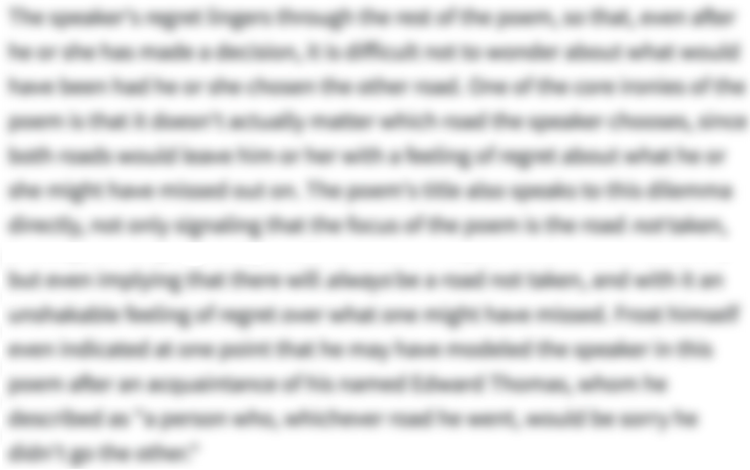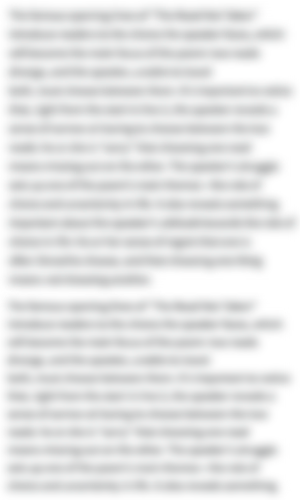The Full Text of “One Perfect Rose”
1A single flow'r he sent me, since we met.
2All tenderly his messenger he chose;
3Deep-hearted, pure, with scented dew still wet—
4One perfect rose.
5I knew the language of the floweret;
6"My fragile leaves," it said, "his heart enclose."
7Love long has taken for his amulet
8One perfect rose.
9Why is it no one ever sent me yet
10One perfect limousine, do you suppose?
11Ah no, it's always just my luck to get
12One perfect rose.
-
“One Perfect Rose” Introduction
-
The American poet Dorothy Parker published "One Perfect Rose" in her first book, Enough Rope (1926). The poem's speaker dryly mocks the clichéd romantic gesture of giving a lover a rose. After sarcastically waxing poetic about the beauty and emotional significance of a single "perfect rose," the speaker jokes that she'd much rather receive "one perfect limousine" as a gift. This poem pokes fun not just at old-fashioned gifts, but at old-fashioned (and rather sexist!) ideas about romance in general.
-
-
“One Perfect Rose” Summary
-
He sent me just one flower after we last saw each other. He chose this flower with great care; it seemed heartfelt and innocent, still fresh with dew. It was a flawless rose.
I understand the intended message of this little flower: its delicate petals are supposed to represent its sender's heart. A flawless rose has long been love's favorite symbol.
But why do you think it is that no one's ever sent me something else—like, just for instance, a flawless limousine? Unfortunately, I always have to make do with nothing but a single—albeit flawless—rose.
-
-
“One Perfect Rose” Themes
-

Romance and Cliché
“One Perfect Rose” implies that old-fashioned romantic gestures like giving women roses aren’t nearly as moving or touching as they’re cracked up to be. The speaker is thoroughly unimpressed by such mushy, unimaginative gifts, implying that she’d much rather receive “one perfect limousine” than a “perfect,” yet ultimately useless, rose. Beyond simply poking fun at romantic clichés, the poem also suggests that these trite ways of showing affection rely on the outdated idea that women are delicate and sentimental. The poem, then, subtly challenges tired stereotypes surrounding romance and femininity, suggesting that many romantic traditions don’t fit the context of modern love.
When the speaker’s lover (or a man hoping to become the speaker’s lover!) sends her a rose, the speaker knows that this is supposed to be a tender, sweet, and (almost sickeningly) romantic gesture. She understands full well “the language” of the flower, which has become a symbol of ideal romance and is meant to convey how “Deep-hearted” this man is.
All the while, the speaker’s purposefully over-the-top diction—complete with old-fashioned spellings like “flow’r,” clichéd poetic references to “scented dew,” and emphasis on the fact that this rose is “perfect”—suggests that the speaker isn’t buying it! Her tone mocks the sappy idea that a mere flower represents anything more than a flower, let alone the perfection and “purity” of true romance.
There’s also an implied gender dynamic at play here, as the poem mocks the outdated assumption that the way to a woman’s heart is through sentimental gestures. The speaker makes fun of this naïve belief, sarcastically suggesting that a rose and its “fragile leaves” “enclose” a man’s heart. This is a corny (not to mention unrealistic) idea, yet society still seems to think roses will sweep women off their feet—a pretty condescending outlook, since it treats women as if they’re impressionable, excitable children.
The speaker, for her part, challenges this by making it clear that she’d much rather receive “one perfect limousine” than “one perfect rose.” A limo, at least, would be legitimately exciting! Roses are clichéd and unimaginative—a relic of the past—while limousines are dazzling and modern. This contrast highlights the fact that stereotypical romantic gestures are not only meaningless and even a little sexist, but also tedious and boring.
- See where this theme is active in the poem.
-
-
Line-by-Line Explanation & Analysis of “One Perfect Rose”
-
Lines 1-4
A single flow'r he sent me, since we met.
All tenderly his messenger he chose;
Deep-hearted, pure, with scented dew still wet—
One perfect rose."One Perfect Rose" sounds like a classic love poem—at first. The speaker begins by telling readers of a lover who sent her a "single flow'r," a blossom he selected with great care, "tenderly" choosing it to show the speaker his affection.
The antiquated spelling of "flow'r" gives the beginning of the poem a fancy, old-timey feel: this is the kind of spelling one would find in a classic love poem. But "One Perfect Rose" was published in 1926, long after poetry had moved past archaic spellings—and long after it had become a cliché to uses roses as symbols of love. The language choices here make it clear the speaker isn't being totally sincere as she describes her lover's romantic gesture.
That hint of sarcasm only grows as the speaker describes the rose her lover sent her:
Deep-hearted, pure, with scented dew still wet—
One perfect rose.The words "deep-hearted" and "pure" imply that this lover thinks the rose is full of profound romantic meaning—and highlight his over-earnest, over-sincere, and actually pretty dull view of romance. In other words, the lover has romanticized romance itself, clearly thinking that giving the speaker a flower is some grand and deeply significant gesture. But the very idea of "one perfect rose" is a shallow cliché, and suggests that this guy's "love" might be similarly shallow.
The speaker's meter makes her cynical point even clearer. The first three lines are in iambic pentameter and the last line is in iambic dimeter. This means that lines 1 through 3 ("A single [...] still wet—") each contain five iambs, or metrical feet consisting of an unstressed syllable followed by a stressed syllable (da-DUM). Line 4, on the other hand, only contains two iambs (two da-DUMs). This isolates the phrase "one perfect rose," calling attention to it and spotlighting the speaker's point: it's kind of ridiculous to hang so much meaning on so dull and obvious a gift.
-
Lines 5-6
I knew the language of the floweret;
"My fragile leaves," it said, "his heart enclose."

Unlock all 261 words of this analysis of Lines 5-6 of “One Perfect Rose,” and get the Line-by-Line Analysis for every poem we cover.
Plus so much more...
Get LitCharts A+ -
Lines 7-8
Love long has taken for his amulet
One perfect rose. -
Lines 9-12
Why is it no one ever sent me yet
One perfect limousine, do you suppose?
Ah no, it's always just my luck to get
One perfect rose.
-
-
“One Perfect Rose” Symbols
-

The Rose
The rose that the speaker receives from her lover plays on the traditional symbolism of roses—that is, beauty and love—to build a new symbol: here, the rose represents not love, but clichéd, outdated ideas about love. The speaker uses a sarcastic, mocking tone to suggest that flowers represent society's stereotypical and old-fashioned ideas about romance and femininity. The men in this poem believe that women will go weak at the knees over the trite gift of a flower—a sexist assumption that treats women as if they're impressionable children. The rose thus symbolizes a worn-out, laughable view of love—and of women.
- See where this symbol appears in the poem.
-

The Limousine
The "perfect limousine" the speaker imagines receiving in lieu of a trite rose symbolizes freedom, luxury, fun, and independence.
This poem was written in the 1920s, a period when women enjoyed newfound and unprecedented independence and power. Wishing for "one perfect limousine" instead of a mere rose, the speaker imagines being offered, not romance, but options: limousines suggest both wealth and the ability to get around on your own. In other words, the speaker doesn't want her lovers to see her as a swooning damsel, but as a modern woman—a person with her own interests, and with places to be!
- See where this symbol appears in the poem.
-
-
“One Perfect Rose” Poetic Devices & Figurative Language
-
Cliché
The poem plays with cliché to call attention to the absurdity of outdated romantic gestures. Using over-the-top, self-consciously "poetic" language like "scented dew" and "floweret"—and building the poem around the well-worn idea of the rose as a symbol of love—the speaker pokes fun at uninspired cultural ideas about romance and women.
The repeated phrase "one perfect rose" plays on the cliché of a "perfect" or "pure" kind of love being something as fresh and lovely as a rose. This image is so old and worn-out that it even appears in the most clichéd of all Valentine's rhymes: "Roses are red, / Violets are blue, / Sugar is sweet, / And so are you." It makes sense that the speaker of "One Perfect Rose" would make fun of her lover for using a similarly trite rose to impress her.
The speaker even mocks the message that roses supposedly send, saying:
I knew the language of the floweret;
"My fragile leaves," it said, "his heart enclose."The word "fragile" highlights the clichéd notion that romance is a delicate blossom—a perspective that comes along with the sexist assumption that women themselves are fragile and sentimental.
In the final stanza of the poem ("Why is it [...] perfect rose"), though, the speaker blatantly challenges the cliché surrounding roses and romance by suggesting that she'd rather receive "one perfect limousine" than "one perfect rose." This illustrates how useless a rose really is. It'd be much more exciting, the speaker implies, to receive something modern and unexpected—something like a limousine, that she could really have fun with. Instead of rehashing old clichés, the poem suggests, lovers would be better off leaving behind unimaginative traditions and expressing their affection in more authentic, genuinely interesting ways.
- See where this poetic device appears in the poem.
-
Personification


Unlock all 266 words of this analysis of Personification in “One Perfect Rose,” and get the poetic device analyses for every poem we cover.
Plus so much more...
Get LitCharts A+ -
Refrain
-
Parallelism
-
Rhetorical Question
-
Consonance
-
Sibilance
-
Alliteration
-
End-Stopped Line
-
-
“One Perfect Rose” Vocabulary
Select any word below to get its definition in the context of the poem. The words are listed in the order in which they appear in the poem.
- Flow'r
- Tenderly
- Deep-Hearted
- Dew
- Floweret
- Enclose
- Amulet
Flow'r-
An old-fashioned spelling of "flower."
- See where this vocabulary word appears in the poem.
-
Form, Meter, & Rhyme Scheme of “One Perfect Rose”
-
Form
"One Perfect Rose" is a 12-line poem broken into three quatrains (or four-line stanzas). This neatly organized structure gives the poem an antiquated, old-timey feel, helping the speaker to parody traditional forms of sentimental love poetry. The shape of this poem, like its language, makes fun of hoary old poetic and romantic clichés.
Each stanza uses a refrain: the last line is always "One perfect rose." This over-the-top repetition gives the speaker yet another opportunity to poke fun at the way poetry idealizes roses and—by symbolic extension—love. The first time the speaker brings up this "perfect rose," readers might think she's serious; by the third mention, though, it's clear that her tongue is firmly in her cheek.
-
Meter
Most of this poem is written in iambic pentameter, meaning that each line uses five iambs, or metrical feet made up of an unstressed syllable followed by a stressed syllable (da-DUM). Take a look at line 1, for example:
A sin- | gle flow'r | he sent | me, since | we met.
This line's regular meter fits right in with what readers might expect from a traditional love poem. After all, iambic pentameter has been a go-to meter for love poetry since before Shakespeare wrote his sonnets.
However, the refrain—which appears in the last line of each stanza—doesn't follow this metrical pattern. Instead, it's in iambic dimeter, meaning that it contains only two iambs instead of five (two da-DUMs):
One per- | fect rose.
This change in meter is noticeable, since the refrain is so much shorter than any of the other lines. As a result, readers have a moment to think about the phrase "one perfect rose"—and a chance to really consider the clichéd obsession people have with roses and all that they supposedly symbolize.
These sudden shorter lines might also sound almost incomplete—an effect that suggests that a single rose as a romantic gift might leave one feeling less than satisfied.
-
Rhyme Scheme
"One Perfect Rose" follows an ABAB rhyme scheme—and even uses exactly the same rhymes every time. Across the whole poem, then, the pattern of rhymes looks like this:
ABAB ABAB ABAB
This rhyme scheme gives the poem an uncomplicated, musical quality, as if it were a nursery rhyme or a childish song. This simplicity fits in with the poem's overall tongue-in-cheek, parodic tone: a simplistic rhyme scheme helps the speaker to mock a simplistic view of romance.
The rhyme scheme here also helps to set up the poem's punchline. Every stanza ends with a refrain, and thus rhymes on the same word: "rose." And every time that "rose" appears, the speaker's tone has changed a little. The first time, she sounds almost as if she might be genuinely moved; but by the end, she's transparently fed up with the endless succession of "perfect rose[s]" her lovers always seem to deliver.
-
-
“One Perfect Rose” Speaker
-
The speaker of "One Perfect Rose" is somebody who has recently received a single rose from a lover. Although it's possible to read the poem without making assumptions about the speaker's gender, there's more than a hint here that the speaker is female: the idea of presenting a lady-love with a rose (or comparing her to one) and waiting for her to swoon is about as old as poetry itself.
Many readers see the speaker as Dorothy Parker herself, especially because the poem uses dry humor to playfully mock old romantic traditions—something Parker was well-known for.
Whether one reads the speaker as Parker or not, what's clear is that she's pretty cynical about the idea that a rose is a special symbol of love, seeing this as nothing more than a cliché. And yet, the speaker only ever receives single roses from her lovers, suggesting that she lives in a society that is hopelessly hung up on its own outdated traditions.
-
-
“One Perfect Rose” Setting
-
There's no specific setting in "One Perfect Rose." However, there are a few hints here that the poem takes place in the 1920s, when it was written.
One such hint comes when the speaker wonders why no one ever sent her "One perfect limousine." The limousine, with its connotations of luxury, excess, and fun, feels right out of the "Roaring '20s," a post-war period marked by decadence and partying—and by newfound freedoms for women. Wishing for a limousine rather than a rose, the speaker seems very much a woman of her times, more interested in up-to-date wealth and independence than in soppy, clichéd romantic gestures. In a time when many women began to discard traditional ideas about love, romance, and femininity, the old-fashioned "language of the floweret" just wouldn't cut it any more.
-
-
Literary and Historical Context of “One Perfect Rose”
Literary Context
"One Perfect Rose" appeared in Dorothy Parker's first collection, Enough Rope, which was published in 1926. The poems in this book helped establish Parker as a new voice in the world of poetry in the 1920s, placing her alongside writers like e.e. cummings, Edna St. Vincent Millay, and Ogden Nash—all of whom, like Parker, wrote light verse as well as more serious works.
While Modernist poets like T. S. Eliot, Ezra Pound, and William Butler Yeats wrote densely intellectual poems, Parker (and her fellow American writers mentioned above) often wrote funny, colloquial verse that offered sly observations about everyday life. (And even Eliot dabbled in light verse in Old Possum's Book of Practical Cats: the '20s were a golden era for comic poetry.)
"One Perfect Rose" is one perfect example of Parker's style: here, she wittily pokes fun at the way modern men think they can still rely on outdated romantic traditions. She also mocks the clichéd fascination many poets have with roses as a symbol of love. Obliquely parodying classic poems like Robert Burns's "A Red, Red Rose," "One Perfect Rose" suggests that old ideas of romance have become boring and corny—and perhaps were never all that sincere in the first place.
Parker wasn't only known as a poet, but as a respected critic. After working as Vanity Fair's theater reviewer for several years, she was named to an editorial board for The New Yorker when the magazine launched in 1925. She went on to publish many of her poems there, and became a well-known wit and cultural commentator.
Historical Context
Dorothy Parker's career gained momentum in the 1920s, a decade of relative peace and prosperity in the United States. World War I ended in November 1918, and the celebrations and relief that followed led to what's now known as the "Roaring Twenties"—a period of high spirits and relative economic stability.
During this era, Dorothy Parker became an important cultural figure in the literary world of New York City. Some of the country's most respected magazines flourished in the '20s, including The New Yorker and Vanity Fair. As a critic and poet for both these magazines, Parker was a big presence in New York's literary scene, and a founding member of the famous "Algonquin Round Table"—a group of writers, critics, and actors who lunched together at the Algonquin Hotel.
"One Perfect Rose" was published in 1926 in Parker's first book, Enough Rope. The book was very popular, maybe owing to the fact that Parker's name was by then recognizable from her frequent appearances in the country's most widely-read magazines. But this popularity was also due to the wit and humor of her poetry, which aligned nicely with the Roaring Twenties and the exciting sense that popular culture was beginning to shift away from boring old clichés and traditions.
-
More “One Perfect Rose” Resources
-
External Resources
-
A Reading of the Poem — Listen to Dorothy Parker herself reading "One Perfect Rose."
-
A Video Biography — Watch a short documentary about Parker's life and work.
-
The Paris Review Interview — Read the Paris Review's "Art of Poetry" interview with Dorothy Parker, which showcases her classic wit and sheds light on her approach to poetry.
-
The Dorothy Parker Society — Learn more about Parker's enduring influence at the website of the Dorothy Parker Society.
-
The Algonquin Round Table — Read about the Algonquin Round Table, the influential artistic circle with which Parker worked and schmoozed.
-
-
LitCharts on Other Poems by Dorothy Parker
-








